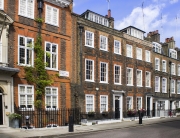2020 started on a positive note, with the results of the UK General Election injecting renewed confidence into the London real estate market. Dubbed the Boris Bounce, the decisive victory for the Prime Minister has resulted in a flurry of transactions, particularly in the Prime Central Residential sector. Despite this, experts have cautioned that operational issues persist, and the market will continue to reflect this uncertainty. All factors considered, here are three asset classes to watch this year:
1. Private Rented Sector (PRS)

The Private Rented Sector is the fastest growing residential segment in the UK [Photo Credit: Unsplash]
The PRS sector in the UK has experienced rapid growth over the last few years, and Knight Frank has predicted that the total investment into the sector will reach £75 billion by 2025. Notable investors from Asia include CDL, which acquired a site in Leeds to develop a 664 unit PRS scheme, and Capitaland, which has pledged in invest £2.5bn into UK Build to Rent, hotels & serviced apartments.
This year will be particularly interesting as the first stabilised PRS developments could be traded in the market, setting the precedent for such assets in the future. Given the compressed yields of student accommodation, a similar asset class, expect to see more institutional investors who have invested in the former exploring the PRS market.
While the residential market was buoyed by recent events, the effects were mostly felt in the London Prime Central region. Affordability remains a major issue in London, underpinned by a longstanding undersupply of homes. As such, demand for rental homes will only continue to grow in the new year. In the same vein, lacklustre sales will likely persist in 2020, making multifamily a likely exit option for developers.
2. Foodstores

Supermarkets are a resilient subset of retail [Photo Credit: Unsplash]
While retail suffered last year, bearing the brunt of the e-commerce boom, one subset of retail remained resilient. According to Knight Frank, investor demand remains strong for prime, long income, index-linked foodstores. The transacted yields for such asset are at under 4%, reflecting the competitive pricing for supermarkets in prime locations. In terms of covenants, while the ‘Big 4’ continue to battle for market share, investors are increasingly open to discounters such as Lidl and Aldi, with prime location deals reported at sub-4%.
Foodstores are popular with institutional and private investors looking for long-term income with strong covenants, at smaller ticket sizes than traditional office assets. With funds divesting their retail portfolios given the weak performance of the asset class overall, it is possible that we will see some promising food store assets in the market this year. However, given the appetite, it is likely that yields will remain competitive.
It is worth noting that for investors with a bigger risk appetite, food store assets in larger footprints present the opportunity for conversion to residential mixed-use.
3. Prime Central London Office
Expect strong demand for London commercial properties in 2020 [Photo Credit: Unsplash]
London is a key global financial centre and continues to thrive in the face of political uncertainty. Hard Brexit notwithstanding, London will continue to attract companies and job seekers alike. The lack of new commercial stock in Prime Central London will mean that rents will continue to rise, making the sector one to watch in 2020.
Based on data from the Office of National Statistics, unemployment rates in the UK remained at a low of 3.8%, the lowest since 1974. Provisional data showed that in the first quarter of 2019, there were 6.1 million jobs in London, a 1.7% increase year-on-year. Oxford Economics forecasts that about 203,000 new office jobs will be created in London over the next five years, generating more demand for office space.
With the lack of new commercial buildings, rents for Grade A office space over 5,000 sq ft in London’s West End, Midtown and South Bank are set to increase in the first half of 2020, based on research by Carter Jonas. In particular, West End offices rents are forecasted to grow 3% by the last quarter of 2020.
Figure 1 shows the net zero yield hurdle and current yields of key European office markets. London has the lowest ‘Net Zero’ hurdle, or minimum income yield needed to offset capital expenditure and management costs. It also has the highest current yield, making it an attractive option for investors looking to acquire assets in Europe.
Figure 1: Net Zero Yield vs Current Yield in Key European Office Markets
Source: CBRE


